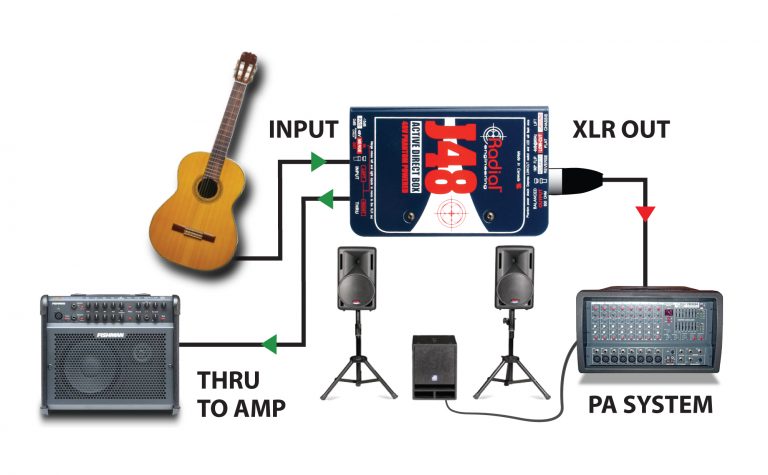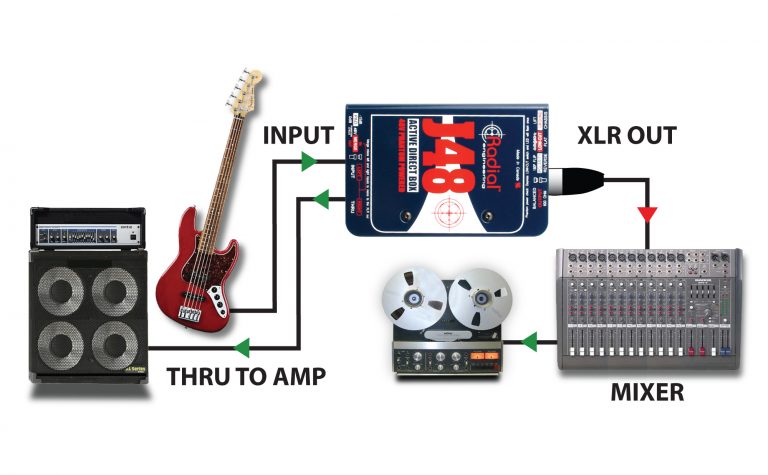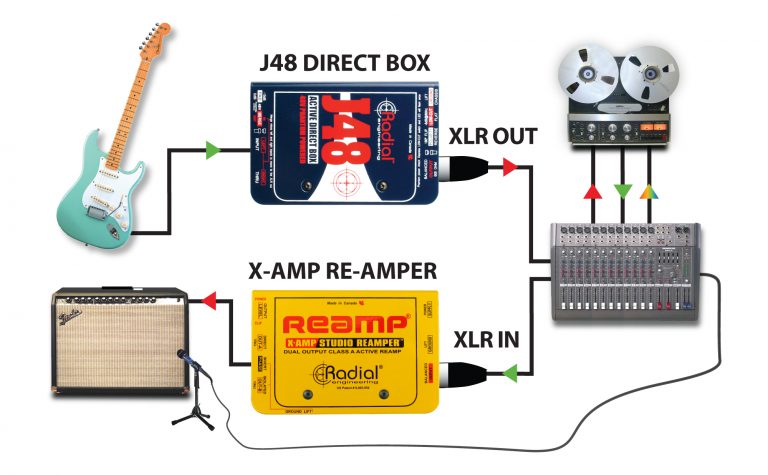Radial Engineering R8003001 J48, Phantom Powered Active DI
- Vendor
- Radial
- Regular price
- $249.99
- Sale price
- $249.99
- Regular price
-
$300.00 - Unit price
- /per
Adding product to your cart
- Description
- Applications
- Features
- FAQ
- Specs
Higher Rail Voltage, Higher Headroom
Most battery-powered guitars and basses will produce as much as 7 Volts when played at maximum volume, which can easily overload typical active direct boxes which have are only able to handle about 3 Volts. The J48 uses a unique switching power supply that raises the internal rail voltage so it can handle up to an incredible 9 Volts, resulting in improved signal handling and greater headroom. This additional headroom significantly reduces distortion of all types, allowing the natural tone and character of the instrument to shine through.
J48 for Live Touring
A direct box is primarily used to get an instrument signal from the stage to the mixing desk and PA system. The Radial J48 delivers the natural tone exceptionally long distances without adding distortion or coloring the sound in any way. J48 in the Studio
J48 in the Studio
When recording direct, the quality of the direct box interface assures the purest signal going to the track. The Radial J48 is particularly well suited for recording bass or capturing a direct track from a guitar. Reamping with the J48
Reamping with the J48
Reamping means sending a dry track from the recorder back out to pedals and amps. This tricks has been used for years by top professionals. The Radial J48 is ideally suited to capture the sound of the instrument for later Reamping.

- Exceptional headroom & dynamic range
- Retains the natural sound of the instrument
- Merge switch sums stereo instruments to mono
- Powered by 48V phantom, no batteries required
How do I get the 48V Check LED to light up on the J48?
The 48V Check LED on the J48 will not automatically illuminate when phantom power is fed to the unit. In order for the LED to demonstrate the presence of phantom power, you will need to engage the J48’s Low Cut switch. Once engaged, the 48V LED should blink once to demonstrate the presence of phantom power at the device. We designed the J48 to function this way so that we could direct as much voltage and current to the actual performance of the J48 as possible.
What is a direct box anyway?
A direct box is an impedance matching and signal-balancing device. DIs convert hi-impedance instrument signals to mic-level balanced lines for interface with pro-audio equipment such as mixing consoles. A good direct box will ensure proper electrical signals are maintained throughout the signal chain and allow long cable runs without added noise. A good DI box is just as important as a good microphone.
What is the difference between an active and passive DI?
This is somewhat similar to comparing dynamic mics to condensers. Active DIs have a built-in pre-amp that requires power to run while passive DI’s use a transformer to convert the signal. Both ‘transform’ or convert the instrument’s high-impedance output to a low impedance balanced microphone level. This allows long cable runs without adding unwanted noise and will improve the instrument’s sound quality. The J48 uses phantom power to derive its power source.
What is phantom power and will it harm my other equipment?
Phantom power is a 48 Volt DC supply that comes from the mixing console on pins 1 and 2 of the XLR connector. It was originally designed to provide power to condenser microphones. It is usually 48 volts and between 5 and 15 mA. Most equipment used in pro-audio today is designed to interface when phantom is on. As such, phantom power will generally not harm your equipment.
Why do people use active direct boxes?
Active direct boxes tend to have more ‘reach’ in that they can capture harmonics and dynamics that can be lost with low-performance passive direct boxes. They are also less prone to loading the instrument, which can change the instrument’s tone.
Can you explain loading?
Years ago, most bass guitars used regular output pick-ups such as those found on Fender basses. Musicians found that connecting the bass ‘thru’ a direct box and then splitting the signal to their amplifier caused the sound to change. This was caused by the added load of the direct box driving the signal to the mixer (and cable) that could be as far as 300 feet (100 meters) away. This would reduce the level going to the amplifier and change the tone.
- Audio circuit type: Proprietary analog circuit with low-noise op-amp
- Frequency response: 20Hz ~ 20kHz
- Dynamic range: 109dB
- Total harmonic distortion: 0.002% @ -5dBu
- Intermodulation Distortion: 0.003% @ -3dBu
- Phase Deviation: +10º at 20Hz | 0º at 1kHz | -1º at 20kHz
- Input Impedance: 220kΩ - ¼" input
- Output Impedance: 200Ω - XLR output
- Equivalent Input Noise: -103dBu
- Noise: -99dB below 0dBu
- Maximum Input: +10dBu
- Features
- Input pad, Mono Sum, 180° polarity reverse, Ground lift, HPF
- Input Connectors: 1/4"
- Output Connectors: Balanced XLR, 1/4" Thru
- General
- Construction: 14 gauge steel chassis and outer shell
- Size (L x W x D): 3.3" x 5.0" x 2" (84 x 127 x 48mm)
- Weight: 1.55 lb (720 g)
- Power: 48V phantom - proprietary digital switching
- Conditions: For use in dry locations only between 5°C and 40°C
- Warranty: Radial 3-year, transferable


















